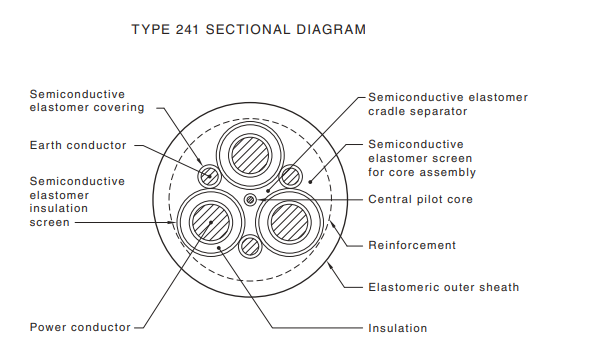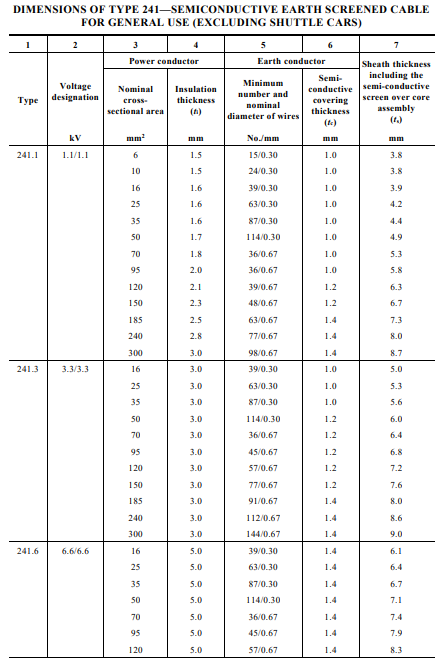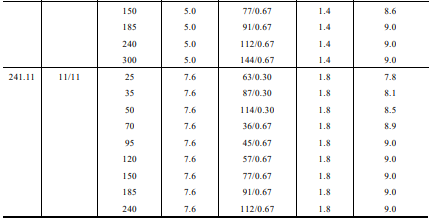AS/NZS 1802 TYPE 241.1 Mining Cables: Powering Australia's Gold and Copper Operations
Comprehensive guide to AS/NZS 1802 TYPE 241.1 mining cables for Australian gold and copper mines. Learn about electrical parameters, applications at major mining sites like Boddington and Kalgoorlie, and essential FAQ for underground operations.
7/9/202511 min read


AS/NZS 1802 TYPE 241.1 Mining Cables: Powering Australia's Gold and Copper Operations
Introduction
In the demanding world of Australian mining, reliable electrical power distribution forms the backbone of successful operations. Whether you're working deep underground in the Cadia Valley or across the vast open pits of Kalgoorlie's Super Pit, the quality of your electrical infrastructure can make or break productivity, safety, and profitability. This is where the AS/NZS 1802 standard comes into play, providing the technical framework for flexible trailing and reeling cables specifically designed for mining applications.
The AS/NZS 1802 standard represents decades of engineering expertise and real-world testing in some of the harshest industrial environments on Earth. Among its various cable types, the TYPE 241.1 specification stands out as a versatile solution for 1.1 kV applications, offering the perfect balance of flexibility, durability, and safety features that modern mining operations demand.
Understanding these cables isn't just about technical specifications—it's about appreciating how proper electrical infrastructure enables the extraction of precious metals that drive Australia's economy. From the semiconductive screens that provide earth fault protection to the robust PCP sheath that withstands constant flexing, every component serves a critical purpose in maintaining safe, efficient operations.
Major Gold and Copper Mines in Australia
To truly understand the importance of TYPE 241.1 cables, we need to examine the extraordinary mining operations where they're deployed. Australia's gold and copper mining industry represents a fascinating blend of cutting-edge technology and traditional extraction methods, with each major operation presenting unique challenges that demand specialized electrical solutions.
Boddington Mine in Western Australia stands as Australia's premier gold and copper producer, consistently delivering approximately 590,000 ounces of gold annually. What makes Boddington particularly interesting from an electrical perspective is its commitment to renewable energy integration. The mine has made significant investments in wind power purchasing agreements, creating a complex electrical grid that requires sophisticated cable management systems. The combination of traditional diesel generators, grid connections, and renewable energy sources means that electrical cables must handle varying loads and power qualities while maintaining consistent performance. In this environment, TYPE 241.1 cables serve critical roles in mobile equipment power distribution, pump circuits, and auxiliary systems that keep the operation running smoothly.
The Cadia Valley operation in New South Wales, owned by Newmont following their acquisition of Newcrest, presents a completely different set of challenges. This underground panel-cave operation produces around 464,000 ounces of gold annually, but the underground environment creates unique electrical demands. The constant movement of equipment, the need for flexible power distribution to mobile machinery, and the harsh underground conditions require cables that can withstand mechanical stress while maintaining electrical integrity. Here, TYPE 241.1 cables are particularly valuable for continuous mining equipment, underground conveyor systems, and the complex network of pumps that keep the operation dry and functional.
Kalgoorlie Super Pit, operated by Northern Star Resources, represents the pinnacle of open-pit mining in Australia. As the largest open pit in the country, the Super Pit creates electrical challenges on an almost incomprehensible scale. The massive scale of operations means that electrical systems must span enormous distances while maintaining power quality for everything from massive excavators to precision drilling equipment. The open-pit environment exposes cables to extreme temperature variations, dust, and mechanical stress from constant vehicle movement. TYPE 241.1 cables in this environment must demonstrate exceptional durability and flexibility, particularly in applications involving mobile equipment and temporary power distribution systems.
The Tropicana operation, a joint venture between AngloGold Ashanti and Regis Resources, showcases how modern mining operations integrate multiple extraction methods. The combination of open-pit and underground operations creates complex electrical distribution requirements, where cables must transition between different environmental conditions while maintaining consistent performance. This hybrid approach to mining demonstrates why flexible, robust cables like TYPE 241.1 are essential for modern operations.
St Ives, operated by Gold Fields, produces approximately 372,000 ounces of gold annually through a combination of multiple open-pit and underground mines. This diversity of operations within a single mining complex illustrates the versatility required from electrical infrastructure. TYPE 241.1 cables at St Ives serve various functions, from powering underground development equipment to supporting surface processing facilities.
Other significant operations including Telfer, Tanami, Jundee, Gruyere, Wiluna, and Gwalia each contribute to Australia's mining landscape, with each operation presenting unique electrical challenges that highlight the importance of robust, flexible cable solutions.
Typical Application Scenarios of TYPE 241.1 Cable
Understanding where and how TYPE 241.1 cables are used in mining operations helps illustrate their critical importance to Australian mining success. These cables aren't just passive conduits for electricity—they're active components that must adapt to the dynamic, demanding environment of modern mining operations.
Continuous Miners and Mobile Equipment: In underground operations like Cadia Valley, continuous miners represent the cutting edge of extraction technology. These massive machines must move constantly through narrow tunnels, creating extreme demands on their electrical supply systems. TYPE 241.1 cables excel in this application because their flexible EPR insulation and stranded conductor design allow for constant bending and movement without compromising electrical integrity. The semiconductive screens provide crucial earth fault protection, ensuring that any damage to the cable triggers protective systems before creating safety hazards.
Pump Systems: Mining operations consume enormous quantities of water for processing and dust suppression, while simultaneously fighting constant groundwater infiltration. Pump systems represent one of the most critical applications for TYPE 241.1 cables, particularly in underground operations where flooding can shut down entire sections of a mine. These cables must operate in constantly wet conditions while providing reliable power to pumps that operate 24/7. The water-resistant EPR insulation and PCP sheath construction make TYPE 241.1 cables ideal for these demanding applications.
Primary Power Feeders: In both underground and open-pit operations, primary power distribution requires cables that can handle significant current loads while maintaining flexibility for equipment movement. TYPE 241.1 cables serve as primary feeders for mobile substations, temporary power distribution systems, and emergency power circuits. The range of conductor sizes from 6mm² to 300mm² provides flexibility for different load requirements, while the robust construction ensures reliable operation even under mechanical stress.
Reeling and Trailing Applications: Perhaps the most demanding application for TYPE 241.1 cables involves reeling and trailing systems where cables must be constantly wound and unwound as equipment moves through mining operations. This application requires cables that can withstand millions of flexing cycles while maintaining electrical and mechanical integrity. The stranded conductor design, combined with the flexible PCP sheath system, provides the mechanical properties necessary for these extreme duty cycles.
The semiconductive screens that distinguish TYPE 241.1 cables from standard industrial cables provide crucial safety benefits in mining environments. These screens create a controlled path for earth fault currents, ensuring that any breach of the outer sheath triggers protective systems before creating dangerous conditions. In underground operations where explosive gases may be present, this earth fault protection becomes even more critical.
Electrical and Mechanical Parameters of TYPE 241.1
The technical specifications of TYPE 241.1 cables reflect decades of engineering refinement specifically for mining applications. Understanding these parameters helps explain why these cables perform so reliably in demanding mining environments.
Voltage Rating and Insulation System: The 1.1/1.1 kV voltage rating represents the cable's ability to handle both line-to-line and line-to-earth voltages safely. This voltage level is particularly well-suited for mobile mining equipment, pump systems, and auxiliary machinery that form the backbone of mining operations. The EPR (Ethylene Propylene Rubber) insulation system provides excellent electrical properties combined with mechanical flexibility and chemical resistance.
The insulation thickness varies from 1.5mm for smaller conductors to 3.0mm for larger sizes, providing appropriate electrical stress control across the full range of conductor sizes. This graduated approach ensures that each cable size provides optimal performance without unnecessary material costs or reduced flexibility.
Conductor Construction and Sizing: The stranded tinned copper conductors represent a sophisticated balance between electrical performance and mechanical flexibility. Tinning provides corrosion resistance in harsh mining environments while maintaining excellent electrical conductivity. The stranding patterns, ranging from 15/0.30mm for 6mm² conductors to 98/0.67mm for 300mm² conductors, optimize flexibility while maintaining current-carrying capacity.
The availability of conductor sizes from 6mm² to 300mm² provides remarkable flexibility for different applications. Smaller sizes (6-25mm²) are ideal for control circuits and auxiliary equipment, while larger sizes (185-300mm²) handle primary power distribution for major equipment. This range allows mining operations to standardize on a single cable type while meeting diverse electrical requirements.
Semiconductive Screen System: The semiconductive covering represents one of the most important safety features of TYPE 241.1 cables. With thickness ranging from 1.0mm to 1.4mm depending on conductor size, these screens provide controlled earth fault protection that's essential in mining environments. The semiconductive material has electrical properties that allow it to conduct earth fault currents while providing insulation under normal operating conditions.
Earth Conductor Configuration: The interstitial earth conductors provide redundant earth fault protection and equipment grounding. This configuration ensures that earth continuity is maintained even if individual earth conductors are damaged, providing crucial safety benefits in underground operations where reliable earthing is essential for personnel safety.
Sheath Construction: The PCP (Polychloroprene) sheath system provides the mechanical protection that allows TYPE 241.1 cables to survive in mining environments. The sheath thickness, including the semiconductive screen, ranges from 3.8mm for smaller cables to 8.7mm for larger sizes. This robust construction protects against abrasion, crushing, and chemical attack while maintaining flexibility for reeling and trailing applications.
Central Pilot Core: Many TYPE 241.1 cables incorporate a central pilot core that provides additional functionality for monitoring and control systems. This pilot core can carry control signals, monitoring data, or provide redundant earth continuity monitoring, adding operational flexibility to the basic power distribution function.




Potential Mining Challenges and FAQ
The harsh realities of mining operations create unique challenges that require specialized solutions. Understanding these challenges and their solutions helps explain why TYPE 241.1 cables have become essential to Australian mining success.
Question 1: How resistant is the cable to abrasion and crushing in underground drifts or open pits?
The abrasion and crushing resistance of TYPE 241.1 cables represents one of their most critical performance characteristics. The heavy-duty PCP sheath construction provides exceptional mechanical protection through multiple layers of defense. The outer sheath resists direct mechanical damage, while the semiconductive screen layer provides additional protection for the underlying insulation system.
The cable's resistance to crushing comes from the overall construction philosophy that distributes mechanical stress across multiple layers rather than concentrating it on any single component. The stranded conductor design allows the cable to deform under mechanical stress without breaking individual conductor strands, while the flexible EPR insulation maintains electrical integrity even under significant mechanical deformation.
In underground drift applications, where cables may be dragged across rough rock surfaces or subjected to falling rock, the braided reinforcement layers provide additional mechanical protection. The semiconductive layers serve a dual purpose, providing both electrical protection and mechanical cushioning that helps absorb impact forces.
Question 2: What happens if the outer sheath is breached underground?
Sheath breaches represent one of the most serious potential failures in mining cable systems, but TYPE 241.1 cables are specifically designed to handle these situations safely. The semiconductive earth-screen layer provides controlled earth fault protection that ensures any breach triggers protective systems before creating dangerous conditions.
When the outer sheath is breached, moisture or conductive materials can contact the semiconductive screen, creating a controlled earth fault path. This controlled fault triggers earth fault protection devices, causing the circuit to disconnect safely rather than creating dangerous conditions. The central pilot core, where present, can provide additional earth continuity monitoring that alerts operators to sheath breaches before they become critical.
The multiple-layer construction means that a breach of the outer sheath doesn't immediately compromise the electrical integrity of the cable. The semiconductive screen provides a protective barrier that prevents direct contact between external contaminants and the insulation system, buying time for protective systems to operate.
Question 3: Can this cable be used in wet or flooded conditions common in gold-copper mines?
Water management represents one of the most challenging aspects of mining operations, and TYPE 241.1 cables are specifically designed to operate in wet conditions. The EPR insulation system provides excellent water resistance, maintaining electrical integrity even when subjected to continuous water immersion.
The PCP sheath construction provides mechanical protection against water ingress, while the semiconductive barriers create multiple lines of defense against water penetration to the conductor system. Even if water penetrates the outer sheath, the semiconductive screen system provides controlled earth fault protection that ensures safe operation.
In pump circuit applications, where cables may be permanently submerged or subjected to high-pressure water exposure, the robust construction of TYPE 241.1 cables provides reliable long-term performance. The stranded conductor design allows for thermal expansion and contraction without compromising the cable's water resistance.
Question 4: Is 1.1 kV sufficient for heavy haulage or conveyor systems at sites like Super Pit?
The voltage rating of TYPE 241.1 cables makes them ideal for mobile equipment and auxiliary systems, but larger fixed infrastructure often requires higher voltage ratings. For most continuous mining equipment, pump systems, and mobile machinery, 1.1 kV provides adequate voltage for efficient operation while maintaining safety margins.
Heavy haulage systems and large conveyor installations may require higher voltage ratings to minimize current levels and reduce conductor sizes. In these applications, TYPE 241.3 (3.3 kV), TYPE 241.6 (6.6 kV), or TYPE 241.11 (11 kV) variants provide the necessary voltage ratings while maintaining the same construction philosophy and safety features.
The choice of voltage rating depends on the specific power requirements, distance of power transmission, and equipment specifications. TYPE 241.1 cables serve as the foundation of mining electrical systems, handling the majority of power distribution requirements while higher voltage variants handle specialized applications.
Question 5: What is the expected service life under constant bending cycles?
The service life of TYPE 241.1 cables under constant bending represents a critical performance parameter for reeling and trailing applications. The AS/NZS 1802 standard mandates high-flex materials and construction methods that provide extended service life under mechanical stress.
The stranded conductor design distributes mechanical stress across multiple small conductors rather than concentrating it on larger conductors, significantly extending flex life. The EPR insulation system maintains flexibility across a wide temperature range, preventing the brittleness that can develop in other insulation materials.
Typical operational life spans several years depending on the severity of the application, with some installations achieving five years or more of reliable service. The pilot core system, where present, provides early warning of insulation degradation, allowing for predictive maintenance rather than reactive repairs.
Regular inspection and proper handling procedures can significantly extend cable life, while proper installation techniques ensure that mechanical stress is distributed appropriately across the cable structure.
Summary and Recommendations
TYPE 241.1 cables represent a sophisticated solution to the complex electrical challenges faced by Australian mining operations. Their robust construction, flexible design, and comprehensive safety features make them ideal for the demanding conditions found at operations like Boddington, Cadia Valley, and Kalgoorlie Super Pit.
The semiconductive earth screen system provides crucial safety benefits that distinguish mining cables from standard industrial applications. This safety system, combined with the robust mechanical construction, ensures reliable operation in environments where electrical failures can have catastrophic consequences.
For mining operations selecting electrical infrastructure, TYPE 241.1 cables provide an excellent foundation for mobile equipment, pump systems, and auxiliary power distribution. The range of conductor sizes from 6mm² to 300mm² provides flexibility for different load requirements, while the standardized construction simplifies inventory management and maintenance procedures.
When higher voltage ratings are required for large fixed installations, the TYPE 241.3, TYPE 241.6, and TYPE 241.11 variants provide the same construction philosophy and safety features at higher voltage levels. This family of cables allows mining operations to standardize on proven technology while meeting diverse electrical requirements.
The selection of appropriate conductor cross-sections should be based on careful load analysis, considering both steady-state current requirements and fault current capabilities. The insulation thickness and mechanical ratings should be verified against site-specific requirements, ensuring that the selected cables provide adequate safety margins for the intended application.
Proper installation and maintenance procedures are essential for achieving optimal service life from TYPE 241.1 cables. This includes proper cable handling techniques, appropriate support systems, and regular inspection programs that identify potential problems before they become critical failures.
The continued evolution of mining operations toward greater automation and electrification will increase the importance of robust, flexible electrical infrastructure. TYPE 241.1 cables provide the foundation for these advanced systems, ensuring that Australian mining operations can continue to lead the world in productivity, safety, and technological innovation.
Through proper selection, installation, and maintenance of TYPE 241.1 cables, Australian mining operations can achieve the electrical reliability necessary for efficient, safe, and profitable operations in some of the world's most demanding industrial environments.

